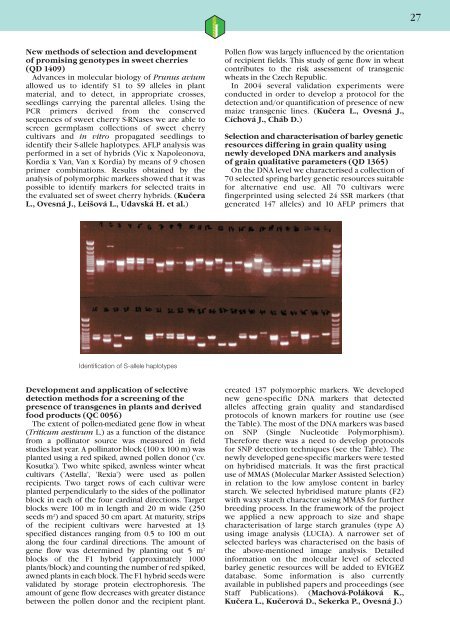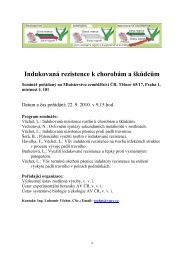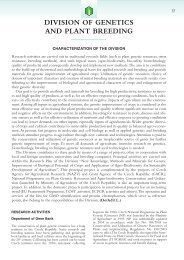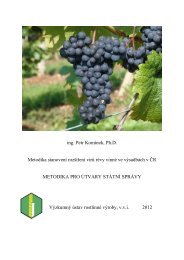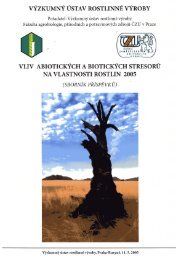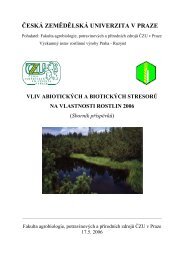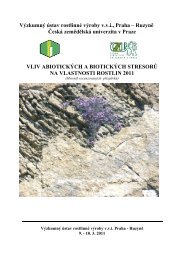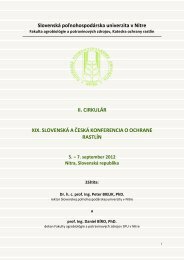You also want an ePaper? Increase the reach of your titles
YUMPU automatically turns print PDFs into web optimized ePapers that Google loves.
27New methods of selection and developmentof promising genotypes in sweet cherries(QD 1409)Advances in molecular biology of Prunus aviumallowed us to identify S1 to S9 alleles in plantmaterial, and to detect, in appropriate crosses,seedlings carrying the parental alleles. Using thePCR primers derived from the conservedsequences of sweet cherry S-RNases we are able toscreen germplasm collections of sweet cherrycultivars and in vitro propagated seedlings toidentify their S-allele haplotypes. AFLP analysis wasperformed in a set of hybrids (Vic x Napoleonova,Kordia x Van, Van x Kordia) by means of 9 chosenprimer combinations. Results obtained by theanalysis of polymorphic markers showed that it waspossible to identify markers for selected traits inthe evaluated set of sweet cherry hybrids. (KučeraL., Ovesná J., Leišová L., Udavská H. et al.)Pollen flow was largely influenced by the orientationof recipient fields. This study of gene flow in wheatcontributes to the risk assessment of transgenicwheats in the Czech Republic.In 2004 several validation experiments wereconducted in order to develop a protocol for thedetection and/or quantification of presence of newmaize transgenic lines. (Kučera L., Ovesná J.,Cíchová J., Cháb D.)Selection and characterisation of barley geneticresources differing in grain quality usingnewly developed DNA markers and analysisof grain qualitative parameters (QD 1365)On the DNA level we characterised a collection of70 selected spring barley genetic resources suitablefor alternative end use. All 70 cultivars werefingerprinted using selected 24 SSR markers (thatgenerated 147 alleles) and 10 AFLP primers thatIdentification of S-allele haplotypesDevelopment and application of selectivedetection methods for a screening of thepresence of transgenes in plants and derivedfood products (QC 0056)The extent of pollen-mediated gene flow in wheat(Triticum aestivum L.) as a function of the distancefrom a pollinator source was measured in fieldstudies last year. A pollinator block (100 x 100 m) wasplanted using a red spiked, awned pollen donor (’cv.Kosutka’). Two white spiked, awnless winter wheatcultivars (’Astella’, ’Rexia’) were used as pollenrecipients. Two target rows of each cultivar wereplanted perpendicularly to the sides of the pollinatorblock in each of the four cardinal directions. Targetblocks were 100 m in length and 20 m wide (250seeds m 2 ) and spaced 30 cm apart. At maturity, stripsof the recipient cultivars were harvested at 13specified distances ranging from 0.5 to 100 m outalong the four cardinal directions. The amount ofgene flow was determined by planting out 5 m 2blocks of the F1 hybrid (approximately 1000plants/block) and counting the number of red spiked,awned plants in each block. The F1 hybrid seeds werevalidated by storage protein electrophoresis. Theamount of gene flow decreases with greater distancebetween the pollen donor and the recipient plant.created 137 polymorphic markers. We developednew gene-specific DNA markers that detectedalleles affecting grain quality and standardisedprotocols of known markers for routine use (seethe Table). The most of the DNA markers was basedon SNP (Single Nucleotide Polymorphism).Therefore there was a need to develop protocolsfor SNP detection techniques (see the Table). Thenewly developed gene-specific markers were testedon hybridised materials. It was the first practicaluse of MMAS (Molecular Marker Assisted Selection)in relation to the low amylose content in barleystarch. We selected hybridised mature plants (F2)with waxy starch character using MMAS for furtherbreeding process. In the framework of the projectwe applied a new approach to size and shapecharacterisation of large starch granules (type A)using image analysis (LUCIA). A narrower set ofselected barleys was characterised on the basis ofthe above-mentioned image analysis. Detailedinformation on the molecular level of selectedbarley genetic resources will be added to EVIGEZdatabase. Some information is also currentlyavailable in published papers and proceedings (seeStaff Publications). (Machová-Poláková K.,Kučera L., Kučerová D., Sekerka P., Ovesná J.)


